
With Microsoft Information Protection Administrator, you’ll take the Microsoft SC-400 exam. The exam is not easy, and in order to pass the exam, you need to join the SC-400 dumps.
The latest SC-400 dumps are worth downloading – courtesy of Pass4itSure.
When looking for free online SC-400 dumps, we recommended a website on the Internet, linked to https://www.pass4itsure.com/sc-400.html, which shares some free questions, all presented in PDF format and VCE, to choose from.
The Microsoft SC-400 exam is an exam for Microsoft Azure solution architects designing and implementing Azure security. By taking and passing this exam, you can demonstrate your expertise and skills in Azure security and earn a Microsoft certification.
Having SC-400 dumps is the most significant opportunity
Having SC-400 dumps is essential because SC-400 dumps provide you with the latest exam questions, which can help you better understand the exam content and format, raise awareness of Azure security, and help you prepare to pass the exam successfully.
Here are some reasons why practicing SC-400 exam questions is necessary:
- Understand the exam content and format:
Practicing SC-400 exam questions can help you understand the question type, scores, time allocation, etc. of the exam so that you can approach the exam more familiar and confident.
- Practice your skills and knowledge:
Practicing SC-400 exam questions can help you consolidate and expand your knowledge and skills in Azure security, allowing you to address real-world job challenges better.
- Assess your level:
By practicing the SC-400 exam questions, you can assess your level and mastery of Azure security and further study and prepare as needed.
- Improve pass rate:
Practicing SC-400 exam questions can help you better understand the difficulty and requirements of the exam, allowing you to better prepare for the exam and increase your pass rate.
In conclusion, practicing SC-400 exam questions is very necessary to help you better prepare for the exam and improve your awareness and skill level about Azure security.
For this reason, here are prepared the latest Microsoft SC-400 exam questions (free of charge) that you can take:
SC-400 actual practice test updated 2023-05
Q1:
HOTSPOT
You have a data loss prevention (DLP) policy that has the advanced DLP rules shown in the following table.
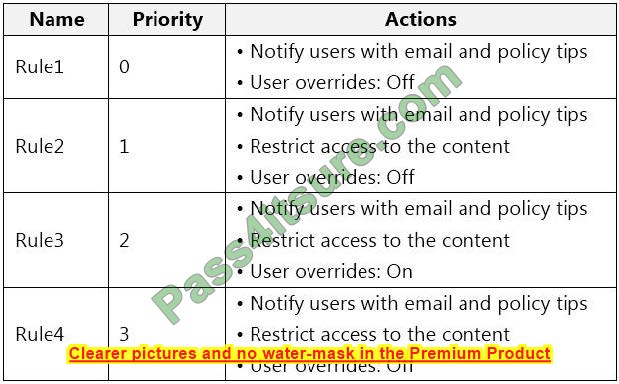
You need to identify which rules will apply when content matches multiple advanced DLP rules.
Which rules should you identify? To answer, select the appropriate options in the answer area.
NOTE: Each correct selection is worth one point.
Hot Area:
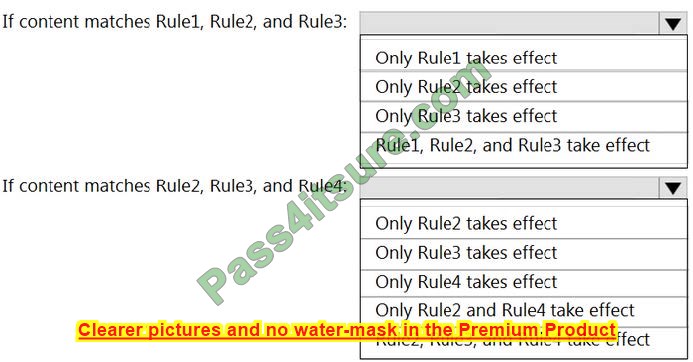
Correct Answer:
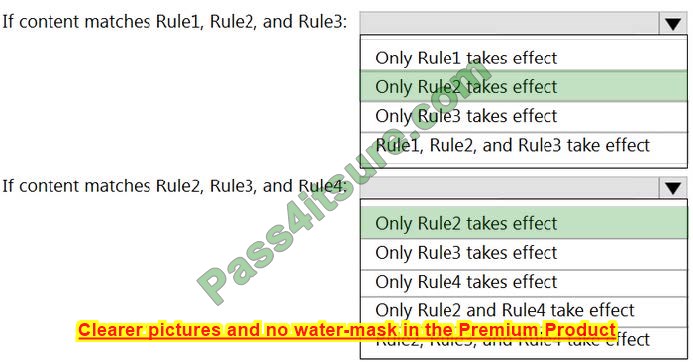
Q2:
You have a Microsoft 365 tenant that uses Microsoft Exchange Online.
You need to recover deleted email messages from a user\’s mailbox.
Which two PowerShell cmdlets should you use? Each correct answer presents part of the solution.
NOTE: Each correct selection is worth one point.
A. Restore-RecoverableItems
B. Get-MailboxRestoreRequest
C. Restore-Mailbox
D. Get-RecoverableItems
E. Set-MailboxRestoreRequest
Correct Answer: AD
Q3:
You receive an email that contains a list of words that will be used few a sensitive information type.
You need to create a file that can be used as the source of a keyword dictionary.
In which format should you save the list?
A. an XLSX file that contains one word in each cell of the first row
B. an ISV file that contains words separated by tabs
C. a JSON file that that an element tor each word
D. a text file that has one word on each line
Correct Answer: D
Keyword dictionaries can be created either from a text file or from csv file.
Note:
There are several versions of this question in the exam. The question has two possible correct answers:
- a CSV file that contains words separated by commas
2. a text file that has one word on each line
Other incorrect answer options you may see on the exam include the following:
- a TSV file that contains words separated by tabs
2. a DOCX file that has one word on each line
3. an XML file that contains a keyword tag for each word
Q4:
You need to create a retention policy to delete content after seven years from the following locations:
- Exchange email
2. SharePoint sites
3. OneDrive accounts
4. Office 365 groups
5. Teams channel messages
6. Teams chats
What is the minimum number of retention policies that you should create?
A. 1
B. 2
C. 3
D. 4
Correct Answer: A
Reference: https://docs.microsoft.com/en-us/microsoft-365/compliance/retention?view=o365-worldwide
Q5:
You have a Microsoft OneDrive for Business folder that contains the files shown in the following table.
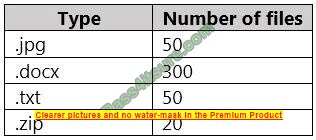
In Microsoft Cloud App Security, you create a file policy to automatically apply a classification. What is the effect of applying the policy?
A. The policy will apply to only the .docx and .txt files. The policy will classify the files within 24 hours.
B. The policy will apply to all the files. The policy will classify only 100 files daily.
C. The policy will apply to only the .docx files. The policy will classify only 100 files daily.
D. The policy will apply to only the .docx and .txt files. The policy will classify the files immediately.
Correct Answer: C
Reference: https://docs.microsoft.com/en-us/cloud-app-security/azip-integration
Q6:
You are evaluating the technical requirements for the DLP reports. Which user can currently view the DLP reports?
A. Admin4
B. Admin1
C. Admin5
D. Admin2
E. Admin3
Correct Answer: E
Q7:
You have a Microsoft 365 tenant.
All Microsoft OneDrive for Business content is retained for five years.
A user named User1 left your company a year ago, after which the account of User1 was deleted from Azure Active Directory (Azure AD).
You need to recover an important file that was stored in the OneDrive of User1.
What should you use?
A. the Restore-SPODeletedSite PowerShell cmdlet
B. the OneDrive recycle bin
C. the Restore-ADObject PowerShell cmdlet
D. Deleted users in the Microsoft 365 admin center
Correct Answer: B
Q8:
You are implementing a data classification solution.
The research department at your company requires that documents containing programming code be labeled as Confidential. The department provides samples of the code from its document library. The solution must minimize administrative effort.
What should you do?
A. Create a custom classifier.
B. Create a sensitive info type that uses Exact Data Match (EDM).
C. Use the source code classifier.
D. Create a sensitive info type that uses a regular expression.
Correct Answer: C
Reference: https://docs.microsoft.com/en-us/microsoft-365/compliance/classifier-learn-about?view=o365-worldwide
Q9:
Each product group at your company must show a distinct product logo in encrypted emails instead of the standard Microsoft Office 365 logo. What should you do to create the branding templates?
A. Create a Transport rule.
B. Create an RMS template.
C. Run the Set-IRMConfiguration cmdlet.
D. Run the New-OMEConfiguration cmdlet.
Correct Answer: D
Q10:
You are planning a data loss prevention (DLP) solution that will apply to computers that run Windows 10.
You need to ensure that when users attempt to copy a file that contains sensitive information to a USB storage device, the following requirements are met:
- If the users are members of a group named Group1, the users must be allowed to copy the file, and an event must be recorded in the audit log.
2. All other users must be blocked from copying the file. What should you create?
A. one DLP policy that contains one DLP rule
B. two DLP policies that each contains on DLP rule
C. one DLP policy that contains two DLP rules
Correct Answer: B
Q11:
You need to meet the technical requirements for the Site3 documents. What should you create?
A. a retention policy that has Only deleted items when they reach a certain age selected
B. a retention label policy and a retention label that uses an event
C. a sensitive info type that uses a regular expression and a sensitivity label
D. a sensitive info type that uses a dictionary and a sensitivity label
Correct Answer: B
Reference: https://docs.microsoft.com/en-us/microsoft-365/compliance/event-driven-retention?view=o365-worldwide
Q12:
After you answer a question in this section, you will NOT be able to return to it. As a result, these questions will not appear on the review screen.
You implement Microsoft 365 Endpoint data loss prevention (Endpoint DLP).
You have computers that run Windows 10 and have Microsoft 365 Apps installed. The computers are joined to Azure Active Directory (Azure AD).
You need to ensure that Endpoint DLP policies can protect content on the computers.
Solution: You onboard the computers to Microsoft Defender for Endpoint.
Does this meet the goal?
A. Yes
B. No
Correct Answer: A
Q13:
You have a data loss prevention (DLP) policy configured for endpoints as shown in the following exhibit.
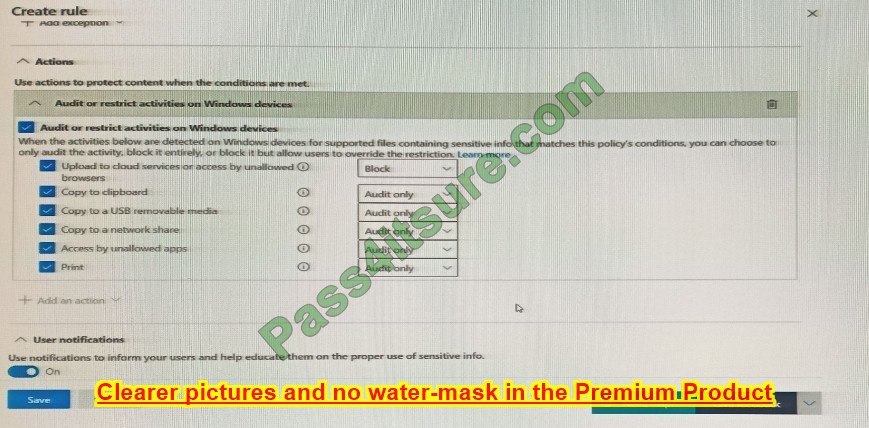
From a computer named Computer1, 3 users can sometimes upload files to cloud services and sometimes cannot. Other users experience the same issue.
What are two possible causes of the issue? Each correct answer presents a complete solution.
NOTE: Each correct selection is worth one point.
A. The Access by unallowed apps action is set to Audit only.
B. The computers are NOT onboarded to the Microsoft 365 compliance center.
C. The Copy to clipboard action is set to Audit only.
D. There are file path exclusions in the Microsoft 365 Endpoint data loss prevention (Endpoint DIP) settings.
E. The unallowed browsers in the Microsoft 365 Endpoint data loss prevention (Endpoint DLP) settings are NOT configured.
Correct Answer: AD
Q14:
You have a Microsoft 365 tenant that contains the users shown in the following table.
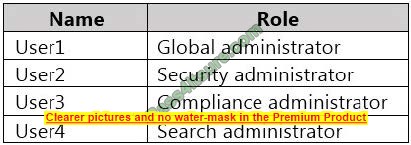
You configure a retention label to trigger a disposition review at the end of the retention period.
Which users can access the Disposition tab in the Microsoft 365 compliance center to review the content?
A. User1 only
B. User2 only
C. User3 only
D. User1 and User3
E. User3 and User4
Correct Answer: C
Q15:
After you answer a question in this section, you will NOT be able to return to it. As a result, these questions will not appear on the review screen.
You are configuring a file policy in Microsoft Cloud App Security.
You need to configure the policy to apply to all files. Alerts must be sent to every file owner who is affected by the policy. The policy must scan for credit card numbers, and alerts must be sent to the Microsoft Teams site of the affected department.
Solution: You use the Built-in DLP inspection method and send alerts by email.
Does this meet the goal?
A. Yes
B. No
Correct Answer: B
Alerts must be sent to the Microsoft Teams site of the affected department. A Microsoft Power Automate playbook should be used.
Reference: https://docs.microsoft.com/en-us/cloud-app-security/content-inspection-built-in https://docs.microsoft.com/en-us/cloud-app-security/flow-integration
For more exam questions, visit the Pass4itSure SC-400 dumps https://www.pass4itsure.com/sc-400.html